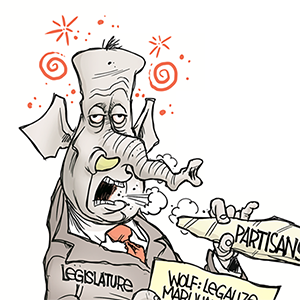DeSantis' attack on this Florida congressional district could have sweeping implications
Published in Political News
FORT LAUDERDALE, Fla. — U.S. Rep. Sheila Cherfilus-McCormick has highlighted the gang-fueled violence plaguing Haiti, and condemned efforts to expel Haitian refugees living in the U.S.
She called attention to the purging of exhibits of the National Museum of African American History months before President Donald Trump’s recent campaign against the museum, and to a sheriff’s deputy killing a Black airman in Okaloosa County, far from her district.
And the congresswoman has delivered funding for cities such as Lauderdale Lakes and Riviera Beach, where most of the residents are Black and many are low-income.
Cherfilus-McCormick, the first Haitian American Democrat elected to Congress, is in a position to command attention and effect change because Florida’s 20th Congressional District was crafted with boundaries that made it likely to send a Black lawmaker to Washington.
Gov. Ron DeSantis wants that congressional district eliminated before the 2026 elections.
The governor argues that 20th District’s structure is an unconstitutional racial gerrymander.
DeSantis, who signed the Florida congressional districts map into law in 2022, after his office created and presented it to the Legislature for ratification, wants an unusual mid-decade redistricting to change congressional boundaries.
His call for new Florida districts comes amid a wave of unusual mid-decade redistricting efforts that began when President Donald Trump demanded that Texas change its map so the state would send five more Republicans and five fewer Democrats to Washington. California responded with a plan to add five Democratic and subtract five Republican districts.
DeSantis has said several times in recent weeks that he sees a need for a mid-decade redistricting. On Wednesday, he delivered his most extensive remarks on the subject to date during an appearance at Palm Beach State College just west of Lake Worth Beach. Hours later, Trump posted praise for Republican efforts, including Florida’s, on social media.
20th District
As DeSantis has joined the fray, he has been citing Cherfilus-McCormick’s 20th District, including several times on Wednesday, when he said it was “configured strangely” and has “arms that kind of go out and try to snag more voters.”
And he said it has “almost like claws that go out. It’s the most irregularly shaped district on Florida’s map.”
The 20th District takes in most of the Black American and Caribbean American communities in Broward and Palm Beach counties.
In Broward, it includes parts of several Broward cities, including Lauderhill, Lauderdale lakes, North Lauderdale, Fort Lauderdale, Pompano Beach, Sunrise and Tamarac.
In Palm Beach County it includes all or parts of West Palm Beach, Riviera Beach, Royal Palm Beach and Mangonia Park, along with the Glades communities near Lake Okeechobee.
The populated areas are connected by a huge expanse of territory that is largely uninhabited Everglades.
Drawing together those communities in the two counties is the way it was possible to create a district designed to, most likely, elect a Black member of Congress.
Voting Rights Act
Districts like the 20th, and the resulting election of Black members of Congress, is what framers of 1980s updates to the Voting Rights Act had in mind. The result was electing people to office who otherwise might never have had access to the corridors of power.
(The original law, passed in 1965, was considered landmark civil rights legislation; its provisions have since been weakened by the U.S. Supreme Court.)
When the changes went into effect in the 1992 redistricting, the result was immediate: Florida elected three Black members of Congress that year — the first Black representatives from the state since the end of post-Civil War Reconstruction in 1877.
One of those elected in 1992 was the late U.S. Rep Alcee Hastings, a Democrat who went on to serve until his death in 2021. He ultimately became a member of the House Rules Committee, the immensely powerful group that governs the flow of business on the House floor.
Cherfilis-McCormick is his successor. She has worked on a range of issues, but advocates said some of her priorities depend on the presence of a Black lawmaker.
Here’s how the Voting Rights Act works: Under the one-person, one-vote principle handed down by the U.S. Supreme Court, boundaries of political districts such as congressional seats, must be redrawn to reflect population changes uncovered every 10 years in the census.
Demographic data are then used to draw some districts that include enough Black or Hispanic residents so that the district’s voters are likely to send a member of that minority group to the Capitol or City Hall.
This can often result in cartographic contortions in which districts twist and turn to pick up pockets of minority residents in different communities.
This part of the law doesn’t sit well with DeSantis. He wants the U.S. Supreme Court, in a case it will hear in the fall, to overturn the way that part of the Voting Rights Act has been implemented. If that happens, he said the state would have no choice but to redraw congressional district boundaries.
And, he’s argued, a state Supreme Court opinion in July is another reason to change districts. That ruling upheld the provision in the 2022 map that had eliminated a north Florida district that previously had been crafted to result in the election of a Black member of Congress.
With that state Supreme Court ruling — all the justices in the majority were appointed by DeSantis — the governor said South Florida district lines need to be reopened.
DeSantis said the Voting Rights Act should protect “an individual’s voters right to go in and cast a vote if you’re a citizen of this country, and that obviously should apply regardless of race.”
But he said “saying that you have to draw these strange districts to be able to manufacture a certain number of folks of a certain race or not race in one district” violates the Constitution.
Palm Beach County Commissioner Bobby Powell Jr., a former Democratic member of the Florida Senate and Florida House of Representatives, said people benefit from the districts created under the Voting Rights Act. Such districts allow for people who once didn’t have a voice to have a representative who has access to the corridors of power where outcomes are decided.
“That has meant the opportunity for people who live in these communities to have a representative who shows up for them,” Powell said. “Up until Alcee Hastings, Palm Beach County never had Black representation.”
Powell, who is Black, said during his time in office people outside the districts he’s represented sometimes come to him because they’re more comfortable reaching out to someone who looks like them. “Having representation is ultimately important and also having someone who you feel hears you and understands where you’re coming from.”
Elijah Manley, who is challenging Cherfilus-McCormick in the August 2026 Democratic primary, said in a statement that DeSantis’ challenge to the Voting Rights Act shows “he wants to erase the voices of Black voters, immigrants, and working people in South Florida. … He is telling us exactly what his agenda is: a New Jim Crow era in Florida.”
Cherfilus-McCormick’s office declined requests to comment.
Help Republicans
Sean Foreman, a political scientist at Barry University, said objections to the Voting Rights Act are a way for DeSantis to advance what the Republicans want — a change in Florida congressional districts.
“It’s going to happen one way or another — it’s on,” Foreman said. “He’s laying the conditions. … He’s making the legal arguments in the political world to help push the process forward.”
J. Miles Coleman, associate editor of Sabato’s Crystal Ball, the nonpartisan newsletter on campaigns and elections from the University of Virginia Center for Politics, said there’s a geographic factor as well.
“The southern part of the state is where the Republicans could have some potential upside,” Coleman said.
If Cherfilus-McCormick’s district changes, it means changes in neighboring districts as lines are moved around, something DeSantis also acknowledged.
Redrawing the boundaries could help the Republicans achieve Trump’s goal: lowering the already diminished number of Democrats in the Florida Congressional Delegation, which now numbers 20 Republicans and eight Democrats.
Five of the Democrats are from South Florida.
Boundary changes could make it harder for those Democrats to win reelection.
National Republicans have targeted one — U.S. Rep. Jared Moskowitz — for defeat next year. His Broward-Palm Beach county 23rd Congressional District is closest in the state; boundary changes adding more Republican neighborhoods and subtracting Democrats could make his reelection effort much more complicated.
DeSantis, at the Palm Beach State College event, said he didn’t know which districts were which. But he repeatedly described details about the shape of Cherfilus-McCormick’s district. And DeSantis and Moskowitz aren’t strangers; in his first term, the governor appointed Moskowitz as state director of emergency management and then to fill a vacancy on the Broward County Commission.
©2025 South Florida Sun-Sentinel. Visit sun-sentinel.com. Distributed by Tribune Content Agency, LLC.
























































Comments